It’s almost tradition that the 270-year-old Vacheron Constantin sets a new high every Watches & Wonders. Last year, time stood still when Vacheron Constantin’s ‘Berkley Grand Complication’ came forth bearing 61 complications, including Chinese and Gregorian perpetual calendars. Less than a year later, the Les Cabinotier division set a new world record for the most complicated ‘wristwatch’ – the Solaria Ultra Grand Complication. This historic feat was achieved with the inclusion of 41 masterful complications, comprising 13 potential patented inventions, five minute repeaters, a Gregorian Perpetual Calendar, and a zodiac sky chart, all encased in a double-sided, compact 45-millimetre case.
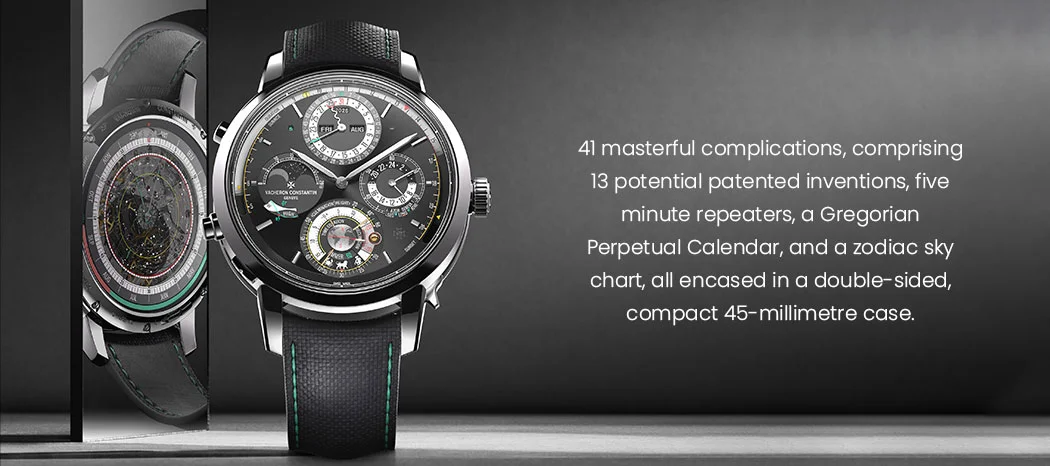
We’re dissecting this wonder of hyper-horlogerie and understanding the complications, one through 41.
Vacheron Constantin’s Legacy of Complexity
For the last decade, Vacheron Constantin has represented the last word in constructing hyper-complicated movements. This began with 2015’s Ref 57260 which overtook Franck Muller’s Aeternitas Mega 5 (36 complications) and Audemars Piguet 11.59 Universelle (23 complications). Honouring the brand’s 260th anniversary, this pocket watch housed no fewer than 57 complications indicating matters of astronomy, calendars, and chronometry. Demanding eight years of R&D, this titan of timekeeping measured two inches wide, two pounds heavy, and tallied 2,600 components. Vacheron Constantin followed this up with last year’s Grand Berkley Complication, which became the world’s most complicated watch with a record-breaking 63 complications – comprising nine for time measurement, Gregorian and Chinese perpetual calendars, Chinese agricultural perpetual calendar, seven for alarms and eight for the Westminster Carillon chimes. This bespoke piece measured 98 millimetres in diameter, 50 millimetres thick and bore 2,877 components.
However, Vacheron Constantin’s first strides in hyper-mechanical movement construction date back to the Art Deco era when automotive mogul James Ward Packard and banker Henry Graves commissioned Vacheron Constantin and Patek Philippe, respectively to create “history’s most intriguing watches”. After years of development and construction, both brands created record-breaking works of art.
A Galaxy on Your Wrist
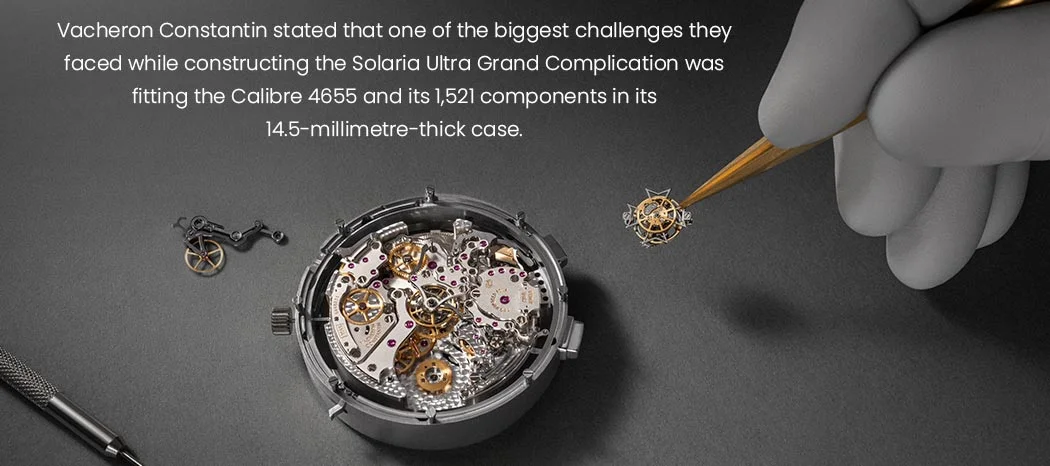
Encapsulating an astronomical catalogue of 41 complications, it surprisingly fits within an ergonomic 45-millimetre 18-carat white gold case that’s just under 15 millimetres thick. Appearing as a sleek chunk of gold, the case was polished featuring eight correctors, two pushers, two selectors, and an elegant slider for the minute repeater.
Unlike traditional ‘hyper-horlogerie’ timepieces, the Solaria Ultra Grand Complication is a far cry from brutalist, cluttered, and old-school design. Given the concentration of complications onboard, Vacheron Constantin prioritized compact legibility. Even with four registers on the front, two of which display up to five complications each and a sapphire caseback that combines a sky chart with chronograph functions, the timepiece is certainly busy yet isn’t overwhelming with complicated windows and registers – exuding a refreshingly modern look.
However, Vacheron Constantin stated that one of the biggest challenges they faced while constructing the Solaria Ultra Grand Complication was fitting the Calibre 4655 and its 1,521 components in its 14.5-millimetre-thick case. This ground-breaking feat of hyper-miniaturisation is a perfect harmony of ergonomic shapes, efficient grouping of mechanisms and strategic placements of complications.
Trilogy of Time
The Solaria Ultra Grand Complication tells time in three disciplines with separate gear trains dedicated to each.
- First, the humble clock that governs humanity, Civil time which is based on a 24-hour day and the International Atomic Time. This is indicated on the front dial by the central hour and minute hands.
- Second, Sidereal time – is displayed on the rear side of the timepiece, minutes are indicated on the periphery of the sapphire crystal caseback while hours are displayed on a rotating desk under it. With a duration of 23 hours, 56 minutes, and four seconds, Sideral time indicates a 360-degree rotation of the Earth.
- Third and finally, Solar time – As the Earth’s orbit around the sun is elliptical and not circular, its axis is inclined at 23. 4 and this ‘tropical’ gear is notoriously good to highlight the peculiarities of solar time. The ‘equation of time’ is displayed on the counter at six o’clock on the front side of the watch, this indicates the difference between solar day and civil day of 24 hours.
Mechanical Hymns of the Cosmos
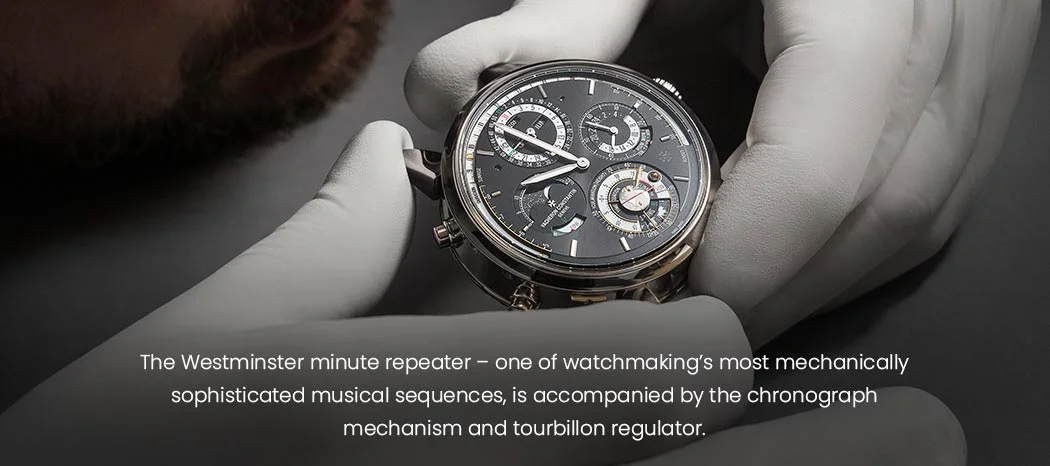
Accounting for seven of the 13 patent applications filed, the Westminster minute repeater – one of watchmaking’s most mechanically sophisticated musical sequences, is accompanied by the chronograph mechanism and tourbillon regulator. While fitting the chimes into the compact case was challenging enough, ensuring the sound quality of the repeater’s chimes was a bigger one. The more ‘cluttered’ a box is, the more unobstructed the sound’s resonance is. After careful R&D, the gongs were rectangular-shaped and attached to the middle case, increasing rigidity on the horizontal plane and preventing colliding when in operation.
An ’Astronomical’ View
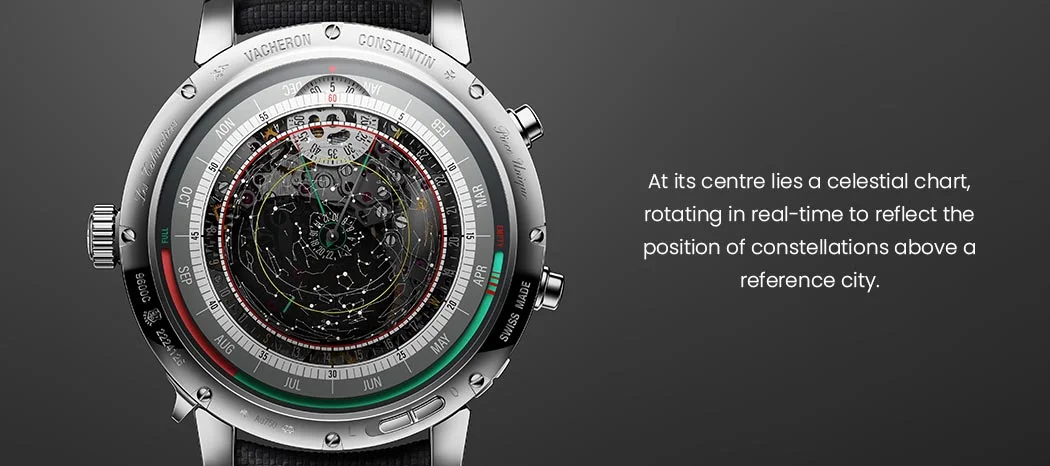
On the reverse side of the Solaria, Vacheron Constantin’s ‘Aim for the Stars’ stride comes to life. At its centre lies a celestial chart, rotating in real-time to reflect the position of constellations above a reference city. Two sapphire discs – one fixed, one mobile, simulate the night sky’s rotation, allowing the wearer to track stellar motion with near-planetarium precision. A poetic complication, yet deeply technical, it bridges horology with the cosmos, reminding us that before clocks, we read time in stars.
Understanding The Complexities
Comprehending the facts, figures, and technicalities of the Solaria Ultra Grand Complication is like curiously exploring a rabbit hole and losing your way – mechanical complexities and staggering achievements stacked one upon another. Exploring time, tide, and the cosmos. Here’s the complete dossier of 41 record-breaking complications, compartmentalized by function and type:
Time Measurement (6)
- Day and night indication for reference city
- Second timezone hours & minutes (24-hour display)
- World time indication – 24 cities
- Second timezone day and night indication
- 3 Hz tourbillon with silicon balance wheel (with high Q factor)
- Civil time display module coupled to the base movement
Gregorian Perpetual Calendar (8)
- Perpetual calendar
- Days of the week
- Date
- Month
- Year Indication
- Leap-year indication
- Indication for the number of the week within the year (ISO 8601 calendar)
- Number of the day of the week (ISO 8601 calendar)
Lunar Indications (3)
- Astronomical moon phases and age of the moon
- Tide level indicator
- Spring and neap times indication
Astronomical Indications (14)
- Indication of seasons, equinoxes, and solstices
- Position of the Sun
- Time of sunrise (city of reference)
- Time of sunset (city of reference)
- Duration of the day (city of reference)
- Equation of time on tropical (solar) gear
- Culmination time of the Sun (city of reference)
- Height of the Sun above the horizon (city of reference)
- Declination of the sun, three-dimensional Earth showing the latitude of the sun in the Northern/Southern hemisphere
- Sidereal hours
- Sidereal minutes
- Astronomical social signs
- Sky chart (city of reference)
- Temporal tracking of celestial objects
Chiming Complications (5)
- Minute repeater
- Westminster carillon chime (4 hammers & 4 gongs)
- Choice of hour-only or full chime
- Crown locking system during the chiming
- Double-stop hammer system to limit rebound and optimize the transmission of hammers’ kinetic energy
Split-Seconds Chronograph (4)
- Chronograph (1 column wheel)
- 60-minute counter
- Split-seconds chronograph (1 column wheel)
- Isolator system for the split-seconds chronograph
Additional feature (1)
- Power-reserve indication (outer disc at 190°)
Patent Applications (13)
Time indications (2):
- ‘Plug and Play’ system – ingenious system for fixing the astronomical module
- Universal time: Ultra-compact system allowing local time to be dissociated from home time without a spring but thanks to the differences.
Astronomical Indications (3):
- Sunrise and sunset times, equation of time, the height of the Sun as well as the culmination of declination of the Sun: system by multi-cam monobloc wheel to reduce the height of the mechanism and increase its precision.
- Celestial Vault: System for displaying the movement of the constellations in real-time by means of two sapphire crystals.
- Identification of Celestial Objects: Indicating the number of hours for a selected star to reach the optimal field of vision.
Chronograph (1):
- Split-seconds Chronograph: Split-seconds insulator system offering better isochronism and reduction of vibration
Minute Repeater (7):
- Minute Repeater Architecture: Optimising the hammer size and maximizing the energy transmitted to the hammers followed by gongs for better sounds.
- Mode Selecter: System for selecting the minute repeater’s striking mode on demand, choosing between hours only or engaging the entire striking mechanism with hours, quarters and minutes.

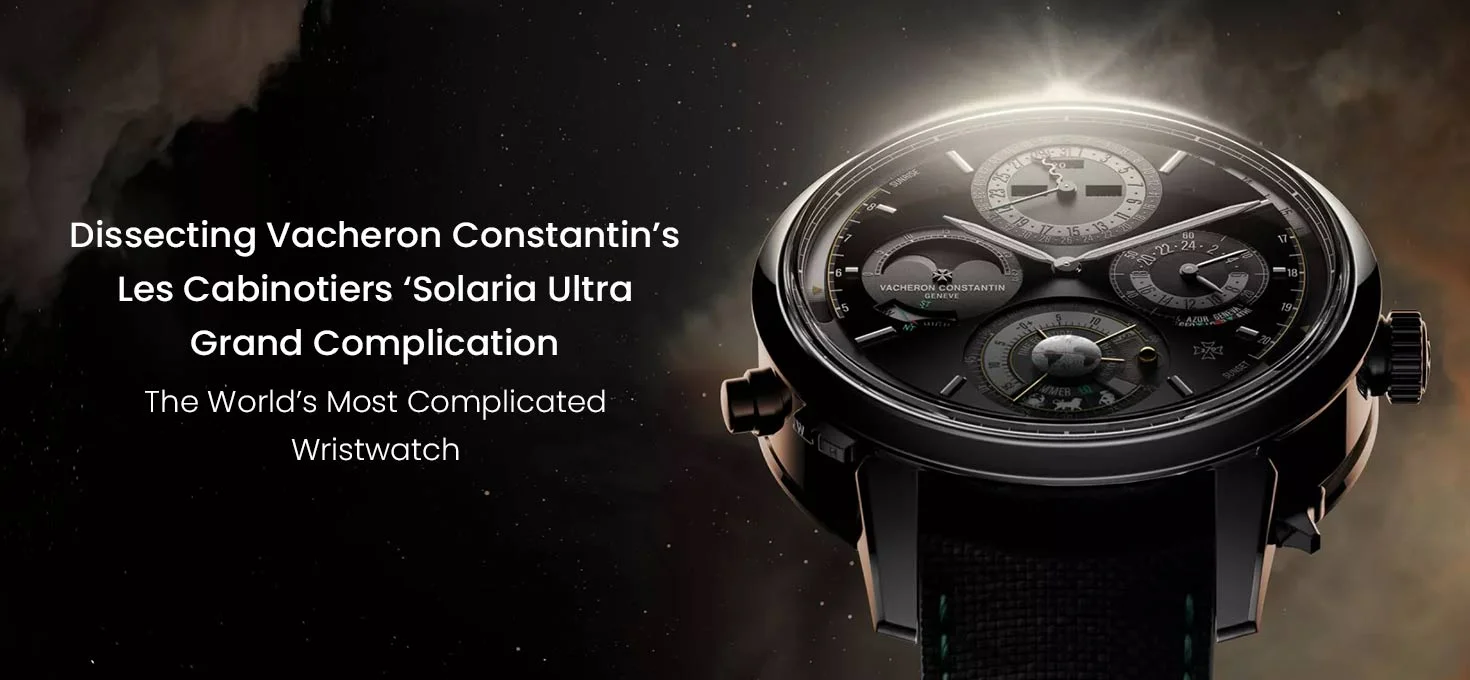

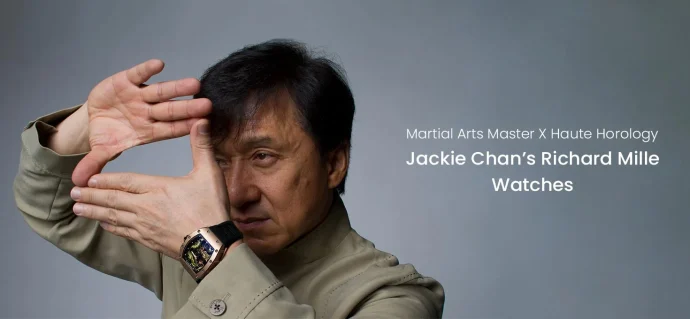

Recent Posts
Recent Comments
Archives